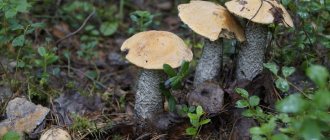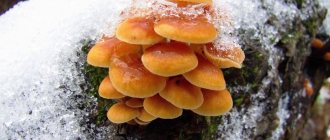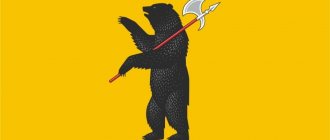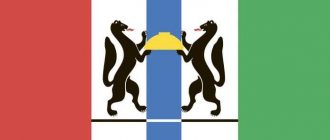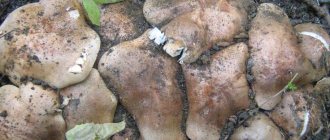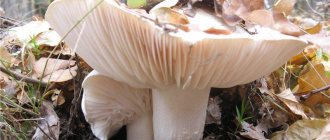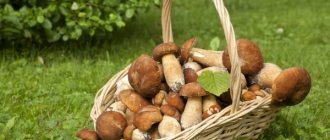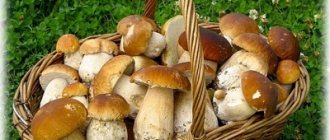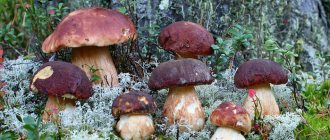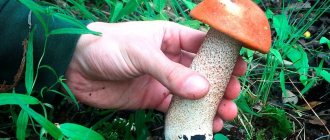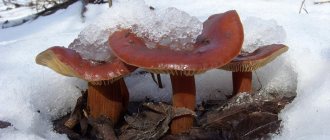Leningrad region is the northwestern region. It is important for amateur mushroom pickers and even professional “hunters” to know mushroom places. The Leningrad region is large, and therefore such information is necessary so that time is not wasted looking for non-existent “riches”. A map of mushroom places will help detectives collect whole baskets of different hats for a large happy family and for sale.
Professionals for whom a decent profit is important prefer to load large body trucks. To collect such a number, you need to travel to many places with a whole team of searchers. All this takes a lot of time, and therefore it is important to know places rich in mushrooms in order to determine in advance the most optimal route. For an amateur, such a map will help you find the nearest place to pick mushrooms, and each of them will have different types of caps, and therefore you can determine the best point, taking into account your preferences.
The region is located in temperate latitudes, at the junction of taiga zones and mixed forests. A map of forests in the Leningrad region shows how the territorial features of places affect the formation of large myceliums. To search at certain times of the year, you must be guided by the mushroom picker’s calendar and knowledge of the area. The annual harvest of mushrooms collected by seekers varies. Every season it changes, and you can only hope for luck. However, mushroom places do not go anywhere; you can travel around the Leningrad region more than once a year.
Priozersky district
Starting from the very north, the Priozersky region is rich in mushrooms. Here you can not only reap a large harvest, but also have a pleasant and useful time. Along with quiet hunting, the trip will give you pleasure with views of beautiful forests and the lake-river system of Vuoksa. Truly picturesque corners will bring joy to those who like to take pictures and study every bush. The peaceful landscape, which is so beautiful with the gentle sun rising, will give you unforgettable moments in the Priozersky region.
Universal tips for mushroom pickers
For thousands of years, people have enjoyed this tasty and nutritious product. And the masters of mushroom hunting have developed a special science of how to properly collect forest gifts. So, one of the rules: they need to be placed with their caps down. Those mushrooms whose legs are long and fragile are placed on their side.
During the excessively wet season, look for mushroom spots in sunny valleys and hills. When summer is dry, mushrooms hide in the depths, under the branches.
They are collected before sunrise. There are two reasons for this. The first is that there are fewer competitors, which means more choice. The second is that in gray light it is easier to see the hats. The oblique rays of the luminary blind the eyes.
The mushroom should be cut as close to the ground as possible - this way the stem will not rot and damage the overall system. The “kids” should be left behind. In a few days they will grow up, and if not you, then they will bring joy to another person.
Fans of “quiet hunting” will definitely love the local mushroom places - Gatchina can be deservedly proud of them.
From north to east
The village of Kuznechnoye immediately catches your eye on the map. The island territory of this place is famous for its mushroom diversity. Chanterelles are most often found here. Since they usually grow in birch trees and mixed woodlands, the village is an ideal place for the development of myceliums. Both boletus and boletus are characteristic of the islands. It's not for nothing that they are called that. You can also find porcini mushrooms. You need to get to the village itself on 4 wheels, but you will have to swim to get to the mushrooms. There are local boatmen who will help you get to the shores of the islands for a small fee. Well, if you carefully prepare for the trip, it won’t hurt to take an inflatable boat with you.
The village of Kommunary is located to the east and slightly to the south. To the east of Millupelto station you can find whole families of a wide variety of mushrooms. High yields attract more and more “hunters” here every year. Getting there is not easy, so it is better to have your own transport.
Even further south and east are the villages of Michurinskoye and Borisovo. The forests between them are famous for milk mushrooms and chanterelles. There is a bus from Sosnovo to the village. This method will help a simple amateur get to the point, because teams need large equipment.
Moving even further south and east, you can get to the village of Losevo. Vuoksa is the largest river in the Leningrad region, originating in Finland. On its bank, near the village, a mixed forest grows. Boletus and aspen boletuses are often found here. Moss mushrooms and chanterelles are also characteristic of this place. There is a bus from Sosnovo and trains from Finlyandsky Station.
The predominance of conifers in the mixed forest of the village of Snegirevki provides an opportunity for the development of families of moss and russula. Oddly enough, there are no less chanterelles here. The place surprises mushroom pickers with its diversity. The bus will help you get to the village.
Elite boletus
In terms of taste, this mushroom is equivalent to white mushroom. In Russia it will germinate in June-July and until October. Experts emphasize that these mushrooms appear en masse in the Gatchina region in early September. Their color is red-brown. They often germinate in aspen forests, but are also found under coniferous trees. In pine forests the mushroom cap will be red, in mixed forests it will be brown.
The boletus grows as a family; it is rarely found alone in nature. Therefore, when you see one hat, look around, maybe his relatives are nearby. Skilled seekers also say that a real boom of these mushrooms occurs once every five years. That is, if last season you identified mushroom places in the Gatchina region, then you should not expect the same harvest next year. Although they often go to the villages of Druzhnaya Gorka and Vyritsa to pick them up. Every year the forests there are abundant with such a harvest.
The amazing village of Sosnovo
The most amazing place in the Priozersky region from the point of view of a mushroom picker is the village of Sosnovo - in the south. It’s easy to get there by train from Finlyandsky Station. The place is large and completely surrounded by mixed forest. It is no coincidence that the village is named so. The predominance of pine, spruce and dry air characterize the forest. The variety of mushrooms is a real joy for a detective. Chanterelles, milk mushrooms, multi-colored russula, white russula, and boletus are just part of the natural wealth of this territory.
Forest dangers
When entering the forest, you should not forget about the danger that may await you. First of all, you need to charge your phone battery well and take with you a first aid kit with the first essentials. A compass will not be amiss in your pocket. It's worth taking mosquito repellent too. Walk with a stick in your hands. Use it to check dense bushes as snakes may be hiding there.
If the forest is unfamiliar, do not go far from your friend so as not to get lost. Wear high shoes made of thick material. Clothing should fit snugly along its entire length. This will protect you from ticks.
Mushroom places in the Gatchina region sometimes have many snakes. But remember, the poisonous ones do not attack first. Newspaper headlines also scare mushroom pickers about bears. But such a meeting is rare. If you do encounter a dangerous animal, be calm - any wild animal is afraid of you just as much as you are of it. In order not to irritate the animal, just do not move. The time of year is no less important. At the end of summer or beginning of autumn, bears have already restored the fat layer that they need for hibernation. Therefore, they will not attack first.
Vyborg
This is the end of the Priozersky region - the richest in mushrooms, but the journey on the map does not stop there. In the west is the city of Vyborg. The pure pine forests of the Leningrad region surrounding the city, mirror lakes, and mountains make this place a truly beautiful corner of nature. Transport connections here are much better developed, and therefore getting to mushroom places is not difficult. In dense forests, many boletus, aspen and porcini mushrooms are found. You need to be extremely careful when moving through the thickets, since the Finnish border passes through them, and it is advisable not to cross it. It doesn't hurt to take a map of the area, a compass or a navigator with you.
When does mushroom season start?
In fruitful years, mushroom pickers in August collect porcini mushrooms, milk mushrooms, saffron milk caps, boletus mushrooms, porcini mushrooms, russula, boletus and other mushrooms in baskets. At the beginning of August, the first honey mushrooms appear, and in the middle of the month - moths and white mushrooms. The second half of August and the first ten days of September are the best times for picking mushrooms.
Interesting materials:
How to make towels soft again? How to make towels? How to make a boarding pass? How to make a laptop keyboard backlight permanently? How to make a constant row in Excel? How to make a post restante parcel? How to make a bandage on the ankle joint? How to rotate the screen on a laptop? How to re-verify the results on the terminal? How to make a congratulation from photos?
Resort area
South of Priozerskoye is the Kurortny district. The mild climate of the Baltic states, relief terrain, and many lakes are a great place for the mushroom kingdom. The area is rich in wide beaches and sand dunes, where you can happily relax after a walk through the forest picking mushrooms. The nature here is not so picturesque, but true hikers will find their joys in many ways. Russula, chanterelles, milk mushrooms, and boletuses grow in these places. In a good year, you can leave here with overflowing baskets of friendly hats.
Graceful boletus
Boletus is a very interesting mushroom. It belongs to the family of “black” mushrooms and does not often grow under birch trees. A young babka (granny is the second name for a mushroom) is like a boletus. They are distinguished by their legs. In the boletus it is longer and has scales. When dried, the mushroom turns black.
These mushrooms love swampy, damp soil. Therefore, before you go into the forest with baskets for money, look where the lowlands are. Mushroom places in the Gatchina region can also be suggested by locals who know these open spaces very well.
Grandmothers ripen for 6 days, then they age and become unfit for consumption. They appear in early summer and grow until autumn. You need to look for them not near the birch tree, but a few meters from the trunk, where the young roots are.
Other areas
The swampy terrain of the Gatchina region is covered with dense mixed and coniferous forests. Around the village of Vyritsa, seekers will find chanterelles and porcini mushrooms. Bitters are less common. By the way, geyser-fountains gushing out of the ground are a miracle of this place.
Kirovsky district is located to the east. Mushroom picking points are the village of Sinyavino and the village of Gory. Near the villages there are forests in which a variety of mushrooms grow: boletus, russula, chanterelles, bitter mushrooms and podgruzdi. White can also be found. You need to get to Sinyavino by bus from the Dybenko metro station, and to the village of Gory by train from Ladozhsky station. Mixed forests predominate in the Kirov region. There are groves and forests. Local lakes are a great place to relax.
In the village of Kolchanovo in the Volkhov region, unfortunately, there is no passenger transport. From the nearest station you will have to travel several kilometers to the Syas River yourself. Behind it is a forest where you can collect boletus, russula, and flywheels.
Mushroom pickers spoke about the most “fruitful” places in the Leningrad region
Traditionally, in the Leningrad region, the mushroom season begins in late July - early August and lasts about a month. Most mushrooms can be found in the Vsevolozhsk, Lomonosov, Kurortny, Vyborg and Gatchina regions. Experienced mushroom pickers told NewInform about this.
“This year, full baskets began to be collected at the end of June. Then, near Luga, we collected a basket of boletus, boletus and moss mushrooms,” said Igor.
According to the mushroom picker, during this period it is difficult to find a standing clearing with a harvest; you need to know the places. In addition, the most revered porcini mushrooms by mushroom hunters were not yet “ready.” And now, when the season is in full swing, you can safely go in search of them. But you still need to choose a place wisely, because mushroom pickers have already plundered all the most famous clearings.
“Yesterday I went to the forest near Krasnaya Gorka. Literally a kilometer from the village, if you go in the direction of Sosnovy Bor, there are entire clearings with whites,” Andrey shared.
Nevskie News / Natalya Polyakova
A little further (from St. Petersburg, towards Sosnovy Bor), as a mushroom picker told us, there is also a village called Mount Valdai. The forest around it is also filled with porcini mushrooms mixed with occasional boletuses. So far, according to Andrey, there are a lot of mushrooms, so if you want to definitely find the harvest, go there. The places are located 70 kilometers from St. Petersburg. You can get there by car in just over an hour. Also, minibus 403 departs from the Kupchino metro station to the villages every half hour. Travel time to Krasnaya Gorka is 1 hour 23 minutes.
The village has a military history museum of the same name. Judging by the reviews, it’s quite interesting there, so you can pick mushrooms and get culturally enlightened.
Dmitry spoke about another place with a “dominance” of porcini mushrooms.
“Near the village of Kurgino, near Gatchina, I took a short walk through the forest. An hour and a half - six buckets of whites. Lots of young and overgrown people. In the end I collected only white hats. There are few boletuses, every other one with meat,” said the mushroom picker.
pxhere.com/
According to him, the forest is not very safe. He came across fresh tracks of a mother bear with one or two cubs. His words were confirmed by Elena. The girl also picked mushrooms in that area just yesterday.
“Mushroom pickers, be vigilant and don’t forget about the forest inhabitants. I found bear tracks today in the forests of the Gatchina region,” Elena said.
It takes an hour and a half to get to Kurgino by car. By public transport it takes much longer, because electric trains pass 15 kilometers from the village. The nearest station is Lampovo. You can walk from it to Kurgino in an hour and a half. Therefore, experienced mushroom pickers prefer to get to the village by public transport: from Victory Square on K-100 to Gatchina, and from there on K151-D to their destination. You can also get to Gatchina by train from the Baltic Station.
“Few people talk about Zakhodskoye. This is in the direction of Vyborg, it’s very convenient by train. You can always pick mushrooms there, even if all the passengers on your train get off there,” said Anastasia.
Nevskie News / Sergey Pavlov
This area, among other things, amazes with the variety of mushroom species. People go there not only for boletuses and boletuses; the forest is also rich in chanterelles, boletus and russula. This is due to the terrain. There are many hills closer to Karelia, so in the lowlands there are all conditions for the growth of the listed mushrooms.
If you are ready to go farther away to pick mushrooms or want to supplement your leisure time with visiting museums or walking around the city, then go all the way to Vyborg. According to Vladimir, there is also a lot of harvest there.
“I most often go to the forest along Svetogorskoye Highway, 16 - 19 km. There are a variety of mushrooms, you can pick whatever your heart desires. Finnish forest roads have been preserved, it’s convenient to get there,” shared Vladimir.
If you are not such a fan of long trips, then you can stop about 50 kilometers earlier, in Kirillovsky.
“This year I decided to experiment and went towards Finland, to Kirillovskoye. Near the lake we picked a whole basket of whites, I was pleased with the harvest. I think I'll go again next weekend, I hope they don't completely dismantle it. And so, I usually go towards Beloostrov, there are a lot of boletus mushrooms there. I don’t know how it is this year,” said Natalya.
Nevskie News / Sergey Pavlov
The ride to Kirillovsky by car is about the same as to Mount Valdai. It takes longer by train. From Finlyandsky Station to Lenin Square metro station the trip takes 1 hour 51 minutes. “Swallows” don’t stop in Kirillovskoye, so you’ll have to take a regular train and brake 20 times along the way. You can shorten the journey a little by taking the train to Udelnaya.
Another avid mushroom picker said that on the way to Kirillovsky you can go to Repino. There are a lot of people there now, but the harvest of boletus and boletus is even greater. Especially if you go deeper into the forest away from other gatherers. Oleg spoke about the situation in Beloostrov.
“There are a lot of mushrooms, but it’s quite damp, so there are a lot of worms. Mainly boletus and redcap. In general, it’s not the best place for picking mushrooms this year, but there are a lot of berries - blueberries and lingonberries are “rowed in buckets,” blackberries can be found,” Oleg shared.
Dmitry, Alexander and Andrey spoke about other places where you shouldn’t go.
“Volkhov district - no mushrooms. Meat alone costs a kilogram of burdocks. In two hours, half the bucket was collected,” Dmitry said.
Nevskie News / Sergey Pavlov
Deciphering the mushroom picker's slang, let us explain that the mushrooms in the Volkhov region are mostly old. Moreover, there are few of them. So it's better to go somewhere else.
“Today we were near Priozersk: there were about a hundred times more people than mushrooms,” complains Alexander.
Andrey, as a person who does not like to travel far and usually looks for mushrooms in the Devyatkino area, said that this year he still had to go in search of them to more remote places. However, he failed at Fox Nose. Too many people know about this place. According to him, if you want to collect something there, you need to literally spend the night near the clearing and not let anyone into it, waiting for the bulbs of the cut mushrooms to respawn.
In addition to the places named by mushroom pickers, the Internet writes about the productivity near Losevo, Borisovo, Michurinsky, Sosnovo, Snegirevka, Zerkalny Lake, the village of Pervomaiskoye, Ryabov, Lake Ladoga, Berngardovka railway station and the site of the old Finnish airfield near the village of Veshchevo.
pixabay.com/
In conclusion, mushroom pickers advised to always take a knife with you to cut mushrooms. Remember, if you pull them out by the roots, no more mushrooms will appear in that place. Treat other mushroom pickers and nature with respect, and then all the clearings that were listed above will retain their fertility for many years to come.
East of Leningrad region
The easternmost region where mushrooms are collected in St. Petersburg is Lodeynopolsky. The village of Alekhovshchina is located on the banks of the Oyat River, this is one of the few places in the Leningrad region where you can find a purely deciduous forest. There are various mushrooms here. Boletus mushrooms grow in a deep pine forest. Nature is interesting, it provides secluded places where you can take a break from the city noise while doing your favorite pastime - quiet hunting.
Names of edible species of mushrooms in the region
In the Leningrad region you can find a wide variety of edible representatives of the Mushroom kingdom.
Polish mushroom
Grows on acidic soils in mixed forests. It is considered a delicacy because of its pulp, rich in beneficial microelements. The cap is usually convex, hemispherical. The leg can reach 14 cm in height.
Boletus
Boletuses, growing in deciduous and mixed forests, are often found on sandy and loamy soils. They are characterized by light brown caps, which are located on large barrel-shaped legs. The pulp of such mushrooms is very fleshy and juicy. Boletus mushrooms are divided into:
- pine;
- birch;
- oak.
Rows
The caps of the rows can have different shapes: in some specimens they are cone-shaped, in others they are spherical. There are mushrooms in which their shape resembles a bell or a mace. Its diameter varies between 3-20 cm.
The stem is usually straight and cylindrical. The cap rarely matches the tone of the stem. Ryadovka is easily confused with its poisonous counterparts. A distinctive feature of the latter is a cap with downward curved edges.
Raincoat
The puffball, also known as the bighead, is found in deciduous forests in early autumn. They have a very unusual appearance and can be distinguished by the following characteristics:
- a rounded cap with small spiky projections that fall off over time;
- short stem assimilating with the cap;
- dense light pulp.
Russula
The caps of these mushrooms are rarely spherical: more often they are flat, have a slight depression in the middle and upward-curved edges. The skin on the cap can be dry or slimy and sticky and simply separates from the pulp. On the inside of the cap there are plates: with a yellowish coating or completely white. The leg is cylindrical, no more than 10 cm in height.
Volnushki
Representatives of this species vary, but the most popular ones are pink and white. These specimens are classified as conditionally edible and require heat treatment before consumption. Their main characteristics include:
- a convex pink or white cap up to 12 cm, on which a depression appears over time;
- a small amount of mucus on the cap;
- a solid stalk in young specimens and a hollow stalk in old specimens.
Saffron milk caps
Ryzhiki are the absolute leaders in taste. Representatives of this species are characterized by wide funnel-shaped caps with rolled up edges. The skin of the mushroom is smooth and moist, usually orange with darker areas throughout its surface. The average height of the stem is 7 cm, it is cylindrical, empty and brittle.
Milk mushrooms
Milk mushrooms grow in groups in mixed and coniferous forests. Initially, their caps are flat-convex, but as the fruits ripen they become funnel-shaped. Usually their color is white, while that of false milk mushrooms is olive or brown. The leg is cylindrical, its height is 7 cm.
Obabki
Representatives of the Boletaceae family have large, outstretched velvet caps and a loose, tubular hymenophore. The leg is thickened, cylindrical, sometimes covered with scales. The flesh of the mushroom is white, but turns black when cooked.
Umbrellas
The umbrella caps are usually very wide, and the thin and often curved legs can reach 40 cm in height. The skin is whitish, and a raised area is clearly visible in the center of the cap. The cap itself is usually spotted: the spots are the remains of cracked skin.
Rogatiki
Externally, cattails resemble corals. They do not have the traditional cap and stem; the fruiting body has the shape of a bush. There are no poisonous representatives of this species, and most hornets are eaten.
Mokhoviki
Moss mushrooms are sometimes confused with gall mushrooms. They grow singly and have such characteristic features as:
- cushion-shaped cap with a diameter of up to 20 cm;
- velvet skin;
- formation of mycorrhiza with pines, spruces and various deciduous trees.
Butter
The growing season for boletus is from early summer to mid-October. The mushroom stems are low and cylindrical. They have hemispherical shiny caps with a diameter of approximately 15 cm. Types of butterflies:
- ordinary;
- granular;
- yellow-brown.
Scaly
The mushroom got its name due to its cap: it has the shape of a sphere or bell, and is all covered with thick scales. The caps of more mature fruits are distinguished by their prostrate shape. Types of flakes and their features:
- golden: a large wide cap is the only edible part of the mushroom;
- ordinary: the fruit is considered conditionally edible, with a bitter taste.
Chanterelles
The predominant shape of chanterelle caps is concave with wavy edges. In the Leningrad region the following varieties grow in early spring:
- ordinary, with caps whose edges have a yellowish tone;
- gray with wavy edges and a depression in the middle of the cap.
Oyster mushrooms
Oyster mushrooms are mushrooms with juicy pulp. They have cone-shaped light-colored legs. The most common color of the mushroom is white, although there are specimens with a purple tint. The fruits are found on old rotting trees or stumps.
Honey mushrooms
A distinctive feature of young honey mushrooms is the ring-skirt on the leg, which can be light honey or dark brown. The caps are usually bright: orange or red. The pulp of honey mushrooms has a pleasant taste and smell.
Duboviki
Oak trees are characterized by velvety caps of a brown or grayish-green hue. The pulp is lemon-yellow, dense, and turns blue when cut. Dubovik grows in July-September in deciduous forests.
Kozlyak
Another name for goat is reshetnik. Its cap can be either flat or convex, usually reaching 8 cm in diameter. In wet weather, its surface becomes oily. In its lower part there is a tubular layer. The mushroom stalk is usually short and curved, tapering at the base.
Valuy
Valuy is a bitter mushroom, but it is still eaten pickled. It is characterized by:
- ocher cap;
- thickened loose leg;
- cream plates;
- pulp with the smell of celery.
Blackhead
Also called black boletus. It has a black cap, which grows up to 16 cm. It is semicircular in young specimens, and more straightened and cushion-shaped in older ones. Its surface is dry and may become covered with mucus after precipitation. The leg is thick, scaly, no more than 12 cm long.
Cobweb
The fruiting bodies of this species come in different sizes. The caps are usually conical and the color varies from ocher to dark red or purple. The pulp is fleshy and thin. Hymenophore lamellar plates are thick and sparse.
Mushroom pleasure
So the journey on the map, where mushroom places are indicated, has ended. The Leningrad region is open for search. When collecting forest delicacies, you should not forget about precautions, which are often forgotten due to the overwhelming joy of the find. You should only collect familiar mushrooms so as not to harm your life and health, first of all, your own, and secondly, your family and customers.
Myceliums are a network of small tubes connecting teams of caps in one small area, and therefore if there is one good mushroom in a clearing, then there are probably a bunch of his friends located somewhere nearby. The main quality of a mushroom picker, or any hunter, is attentiveness.
For harvesting, it is better to use containers where free air exchange will occur, such as a basket or mesh. This way, wild mushrooms will not spoil before they get home, and lovers of delicious food will be able to enjoy an excellent delicacy at the table.
It’s not for nothing that mushroom places are famous for such productivity. The Leningrad region and its forests are characterized by the presence of different tree species: alder, rowan, spruce, aspen, pine, birch, bird cherry. This diversity gives the forest the opportunity to expand the species range of fungi. Swampy terrain is another factor influencing the formation of large myceliums. Looking at the map of places in the Leningrad region, it is worth concluding that this is one of the richest natural places where picking mushrooms is a special pleasure.
King of Mushrooms
The greatest trophy for every forest visitor is the porcini mushroom. It is also popularly known as boletus, belovik, cowshed, and also bugbear. The popularity of the mushroom is explained by its unique taste and attractive appearance. His brown hat and wide leg are hard to confuse with something else.
Grows in mixed pine and spruce groves. The mushroom places of the Leningrad region are full of boletus mushrooms. Their greatest number occurs in the last days of August. Although the hunting season for them can open from the beginning of June to the end of October. Picking mushrooms is easy after rainy days. It is better to go on whites a few days after long rainfalls. Then large and beautiful mushrooms will be waiting for you in the forest.
They grow in warm, humid places, several at a time. If the summer is cool, look for boletus in sunny meadows. Inspect the clearing where you found the white one, because nearby there may be a dozen of the same beauties. In mixed groves, the king of the forest hides under fallen leaves. Mushroom places will be in forests where oaks, hornbeams and birches grow. Most often, boletus grows in fly agarics, whitebeard grass and anthills. These stop signs tell you: boletus mushrooms are nearby.
What mushrooms were born at the beginning of this season in the Leningrad region
The summer representatives who took over the baton from the May lines and morels were the first honey mushrooms. They could be found on logs, rotten wood and stumps of deciduous trees. Mushrooms of the Leningrad region in June, based on their quantitative component, were represented mainly by honey mushrooms.
Also in the first month of summer one could find so-called spike mushrooms. This name is not scientific, but popular. Since ancient times, it has been noticed that the most popular mushrooms begin to appear during haymaking and heading of rye. This is where their name comes from - hayfields or spikelets.
Their official name is boletus, boletus, porcini mushrooms and the “mushroom king” - boletus. They are, without exaggeration, the main goal of true mushroom pickers. In this regard, there is a belief: until the first porcini mushroom is found, the season is not considered open.
What are porcini mushrooms and where are they found?
They have this name due to the fact that the tubular layer of the lower surface of their cap, predominantly in young representatives, remains white even after drying, unlike other mushrooms of this family, in which it turns black.
One of the parameters of their value is the durability of the aroma, which is preserved in any type of processing and in any dish. In terms of taste and nutritional properties and vitamin content, it is the white mushroom that occupies a leading position among all its other colleagues. It belongs to category 1 and is used for food both fresh and dried, salted and pickled.
Antibiotics have been found in it, which are suppressive. There is also official evidence that porcini mushrooms also contain substances that can overcome a number of tumors.
They are most often concentrated in pine forests. Based on the many years of experience of knowledgeable mushroom pickers, their season begins in the last ten days of August and stretches to approximately 10 days. After this period, porcini mushrooms can still be found, but only in small quantities, about ten pieces.
Porcini mushrooms in the Leningrad region mainly live in places such as Kirillovskoye, Yappilya, Mesterjärvi, Zakhodskoye, Gavrilovo, Tarasovskoye, Alekhovshchina and the training ground near Luga.
What can happen when picking mushrooms in the Leningrad region by unprepared amateurs?
According to available official data, on September 10, 2014, in the intensive care unit of the toxicology department of the Research Institute of Emergency Medicine named after. Dzhanelidze turned out to be three St. Petersburg residents who were poisoned by poisonous mushrooms collected in the Vsevolozhsk and Tosnensky districts of the Leningrad region.
According to the head of the above department, Oleg Kuznetsov, it is very difficult to accurately determine the type of fungus that caused the poisoning. Presumably, it could be (the most poisonous mushroom).
Since the beginning of the “silent hunting” season in St. Petersburg, this is already the sixth case of poisoning. The first victims were reported in August - one woman and two men. According to the same manager, to date two patients have been transferred from intensive care, and one victim is still in serious condition.
Thus, it should be taken into account that in the Leningrad region “mushrooms” were not only edible, but also poisonous. It is necessary to take a more careful approach to the issue of choosing a specimen suitable for food.
Is the Leningrad region rich in boletuses?
Among the tubular variety, after the previously discussed white one, it takes an honorable second place, based on the criterion of nutritional value (second category). It is consumed both boiled and fried, pickled and dried. It is recognized as the fastest growing mushroom.
These mushrooms in the Leningrad region are as common as boletus mushrooms. They are the most commonly found and recognizable edible mushrooms. Their main advantage is that boletus mushrooms cannot be confused with any other mushroom, including poisonous ones. However, it is better not to collect flabby specimens, since they will rot in the basket.
According to many years of information from experienced mushroom pickers, it is possible to identify places where there are a lot of mushrooms in the Leningrad region, namely boletus. These include: Mshinskaya, Kanneljärvi, Sosnovo, Kuznechnoye, Vyritsa, Roshchino, Gorkovskoye, Priozersk and Losevo.
Photo: visitkamchatka.ru
